Hey!! From 17,000 kWh/year to less than zero: Steffen E. Eikenberry experience with energy-efficiency and rooftop solar in Mesa, AZ
Steffen Eikenberry
@SteffenMath
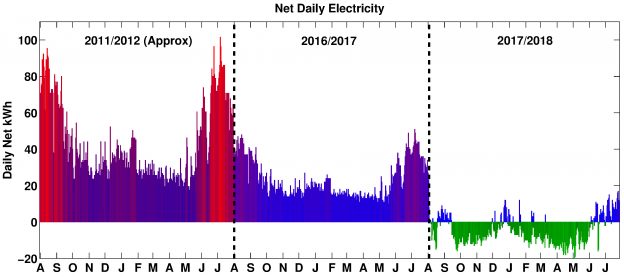
"I wrote several hundred pages of a book that amounted to exhorting people to alter their own habits of residential energy consumption (turn down the heat, you rogues!), as well as upgrade their built environment (e.g. insulate the attic) and appliances, or even, *gasp*, add solar to their roofs. All this because the numbers, at least in the abstract, showed that such banal acts of conservation (not counting solar) can reduce the carbon footprint of residential energy use by at least 30-50%, from a baseline average of about 12 metric tonnes (1 tonne = 1 metric ton) of CO
-equivalent (CO
e). But a demonstration of how, over the course of roughly 5 years, the net energy use in my house actually fell progressively from around 17,000 kWh of electricity per year down to less than zero (net) seems in order.
I will use this post to emphasize that two-thirds of the total energy reduction, and hence carbon reduction, came from inexpensive or free efficiency/behavioral changes. The last third was then fully offset by a relatively cheap 4.48 kW (<$7,000 after tax incentives) solar system. Thus, efficiency and solar should always be pursued in tandem (in my view), as this reduces overall material and energy use far more effectively than solar alone, and minimizes expenses as well.
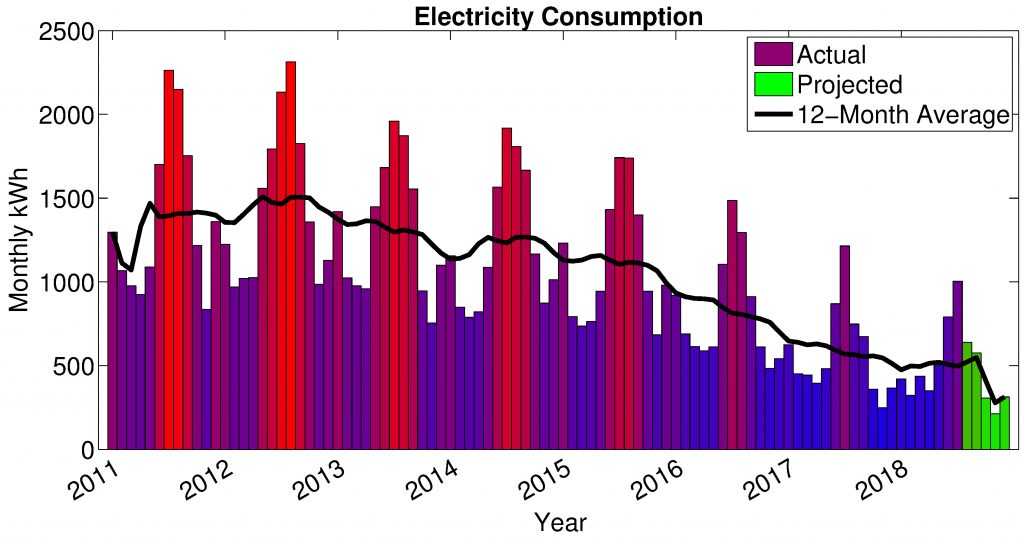
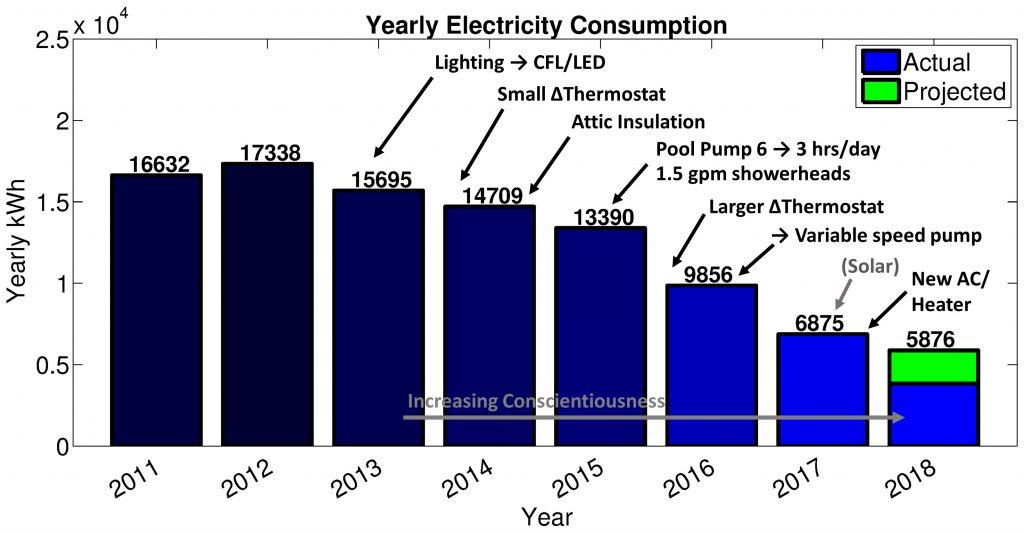
Figure 1 shows monthly electricity consumption from January, 2011 through July, 2018 (and projections through the end of 2018), as summarized from previous monthly bills, for my single family house of around 1,500 square feet, with an in-ground swimming pool (the house is all-electric, so no gas, etc. need be added to the monthly energy total). Note that this consumption represents all on-site residential energy use before incorporating any solar generation into our calculations. Given the setting in Mesa, AZ (part of the Phoenix metropolis), it is not at all shocking that there is a cyclical summer peak, with a much smaller winter peak. Now, what accounts for the dramatic drop (about 66%) in energy use over the years (note that both the peaks and baseline consumption fall progressively)? The answer is rather banal, amounting to the following collection of changes (along with approximate time of implementation and my estimate of energy savings):
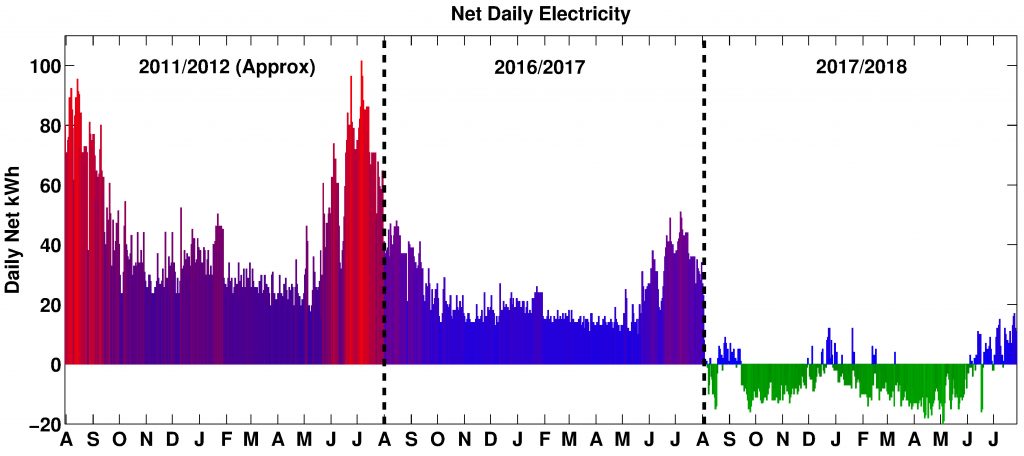
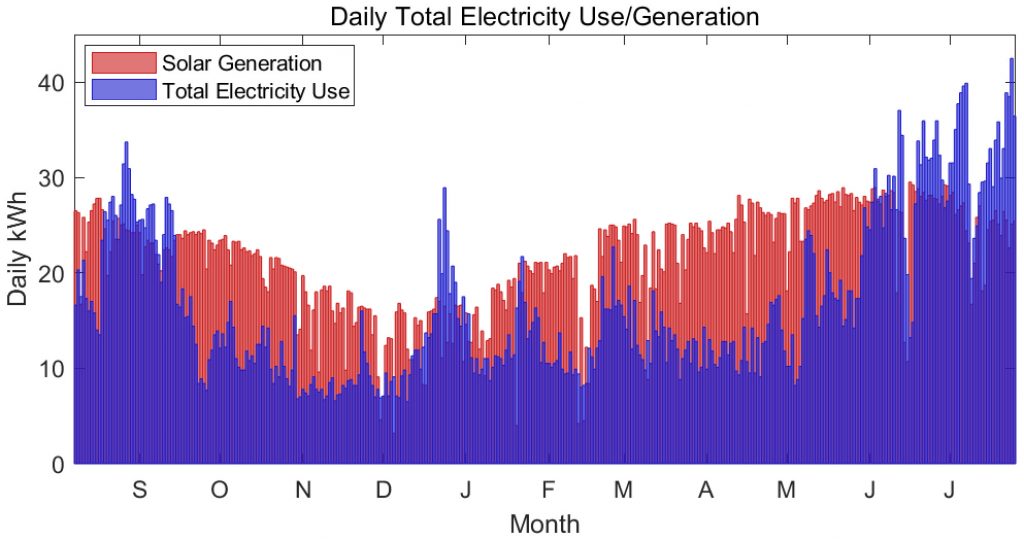
Entering into service on August 3, 2017, our 14-panel, 4.48 kW grid-tie solar system has generated 7,576 kWh at this point, just a few days shy of a single year of operation, and about 1,700 kWh more than the 5,870 kWh consumed in the meantime. Note that this is a grid-tie system, meaning that, during the night and when household demand exceeds solar generation, electricity is drawn from the grid, while when local solar generation exceeds demand, the excess energy is diverted to the grid to be used by other electricity customers. Figure 3 gives daily net energy for yearly intervals before significant conservation (2011/2012, as approximated from later daily energy use data), the year interval before solar (2016/2017), and after solar (2017/2018). Figure 4 shows daily solar generation and total household consumption superimposed on each other.
Now, while the system is net-negative, I still am interested in how much electricity is drawn from the grid, as solar detractors like to point to the fact that grid-tie systems still rely on the grid. Indeed, some go far as to claim that this amounts to solar customers bilking the system and getting a “free ride.” I find this claim absurd on its face, as I still pay a monthly flat fee (one that is appreciably inflated relative to non-solar customers) for the privilege of being connected to the grid, and pay the retail rate for any energy I use. Nevertheless…
Using hourly consumption and generation data available from SRP, in Figure 5 I give an example of a week in late May, showing how during most of the day the local load is covered and excess energy goes to the grid, while at other times there is a load on the grid. Summing hours to days, Figure 6 shows the daily solar energy put on the grid, the daily solar energy consumed locally (i.e. by the house itself), and daily grid energy used.
As can be seen, even if all excess solar energy was lost, the solar system covers roughly half of the local load, and so, even giving zero credit for extra energy production, rooftop solar is highly effective at reducing one’s energy/carbon footprint. In my case, the entire house now only draws about 3,000 kWh from the grid per year, an over 80% reduction from the 2011/2012 baseline.
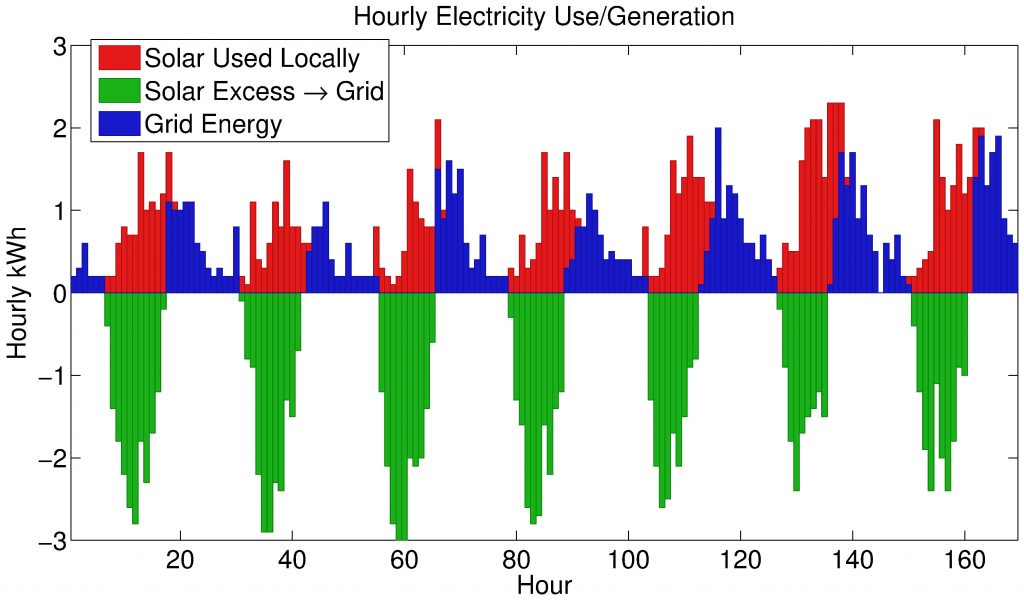
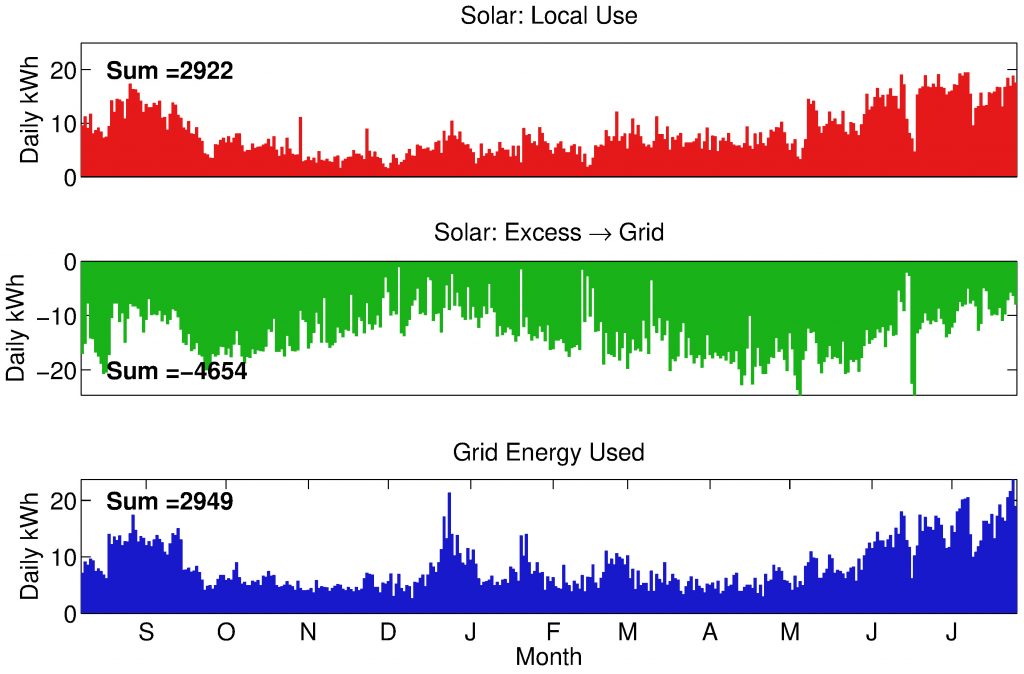
+++++++++++++++++++++++++++++++++++++++++++++++++++++++++++++++++++++++++
Steffen Eikenberry
@SteffenMath
I'm an academic type with a background in medicine, math, and engineering, now primarily interested in how consumption drives global environmental change.
Category Archives: Arizona
Source: http://environmath.org/2018/07/30
I will use this post to emphasize that two-thirds of the total energy reduction, and hence carbon reduction, came from inexpensive or free efficiency/behavioral changes. The last third was then fully offset by a relatively cheap 4.48 kW (<$7,000 after tax incentives) solar system. Thus, efficiency and solar should always be pursued in tandem (in my view), as this reduces overall material and energy use far more effectively than solar alone, and minimizes expenses as well.
Electricity Consumption

Figure 1. Monthly electricity consumption from January, 2011 through July, 2018, with projected use through 2018 (based upon average energy use in 2017 and relative use in 2018 year-to-date).

Figure 2. Yearly electricity consumption and approximate timeline of major accompanying efficiency/behavioral changes. Note that solar (added August, 2017) does not affect energy consumption, but is rather a source of energy generation.
- High efficiency lighting turnover, i.e. CFLs and LEDs (2012/2013, saving 1,000-1,500 kWh/year)
- Roughly four degree ( F) change in the thermostat settings: from 78 to 82 F in the summer months, and from 70-71 to about 67 F in the winter, plus setting the thermostat back when absent (Starting around 2014, becoming more ambitious in 2016; saving 2,000-2,500 kWh/year)
- Blown-in attic insulation (~December 2014, saving additional 500-1,000 kWh/year)
- Single-speed pool pump run-time decreased from 6 hours/day to 3 hours/day (started 2016, saving 1,500 kWh/year)
- Replaced single-speed pool pump with variable speed pump (started 2017, saving an additional 1,000 kWh/year)
- Ultra-low flow shower-heads (1.5 gpm), general reduction in hot water use (started 2015/2016, saving ~1,500-2,000 kWh/year)
- General increase in conscientiousness – turning off TVs, unused appliances, etc. (started 2014/2015, saving 500-1,000 kWh/year)
- New AC/Heat pump in 2017 (saving additional 750-1,000 kWh)
Solar System and Energy Production

Figure 3. Daily net energy for three year-long intervals. After the installation of solar in August, 2017, a net negative value implies more electricity was produced than was consumed.

Figure 4. Daily total solar generation and total electricity use since commissioning of the rooftop array almost one year ago (in August, and so the winter months are towards the center of the graph). Most days generation exceeds demand, with peak summer and winter exceptions.
Now, while the system is net-negative, I still am interested in how much electricity is drawn from the grid, as solar detractors like to point to the fact that grid-tie systems still rely on the grid. Indeed, some go far as to claim that this amounts to solar customers bilking the system and getting a “free ride.” I find this claim absurd on its face, as I still pay a monthly flat fee (one that is appreciably inflated relative to non-solar customers) for the privilege of being connected to the grid, and pay the retail rate for any energy I use. Nevertheless…
Using hourly consumption and generation data available from SRP, in Figure 5 I give an example of a week in late May, showing how during most of the day the local load is covered and excess energy goes to the grid, while at other times there is a load on the grid. Summing hours to days, Figure 6 shows the daily solar energy put on the grid, the daily solar energy consumed locally (i.e. by the house itself), and daily grid energy used.
As can be seen, even if all excess solar energy was lost, the solar system covers roughly half of the local load, and so, even giving zero credit for extra energy production, rooftop solar is highly effective at reducing one’s energy/carbon footprint. In my case, the entire house now only draws about 3,000 kWh from the grid per year, an over 80% reduction from the 2011/2012 baseline.

Figure 5. Hourly energy generation and consumption for an example week in late May. The red bars give solar energy that is used locally (i.e. within the house), while the green bars are the extra solar generation that is put onto the grid. Energy drawn from the grid is represented by blue bars (grid energy is mainly used in the evening after the sun is down, but the AC is still needed).

Figure 6. The top series gives daily solar energy used locally, and below is the solar energy put onto the grid. On the bottom is daily grid electricity consumed. Comparing to Figure 3, note how grid energy used at the summer peak has fallen from almost 100 kWh (in 2011/2012) to under 50 kWh with conservation measures, and finally to less than 20 kWh with rooftop solar added to the mix.
+++++++++++++++++++++++++++++++++++++++++++++++++++++++++++++++++++++++++

